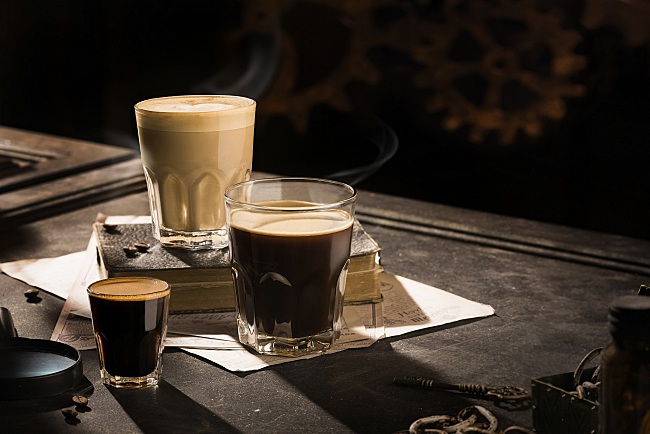SOE Single Origin Espresso – Perfect for Handcrafted Brewing Methods
SOE Single Origin Espresso – Perfect for Handcrafted Brewing Methods
Blog Article
Comprehending Coffee Beans: the Trip From Coffee to Blended Coffee Beans

The Origins of Coffee: A Global Point Of View
While you might assume of coffee as a modern staple, its beginnings trace back centuries, intertwining with societies throughout the globe. The story begins in Ethiopia, where tale states a goat herder named Kaldi found the stimulating impacts of coffee beans after discovering his goats frolicking vigorously after eating them.
As trade routes increased, coffee made its way to Europe in the 17th century, rapidly getting appeal. Each society included its distinct twist to coffee preparation, enriching its history.
Farming and Harvesting of Coffee Beans
As coffee's trip progressed, the emphasis changed to the growing and harvesting of specific bean ranges, particularly those utilized for coffee. You'll discover that espresso beans frequently originate from Arabica or Robusta plants, each offering distinctive tastes. The perfect expanding conditions consist of high altitudes and abundant, well-drained dirt, which improve the beans' quality.
Throughout the harvest, selecting approaches vary. In some areas, workers hand-pick ripe cherries, making certain just the most effective fruit goes to processing. In various other locations, mechanical harvesters are used, specifically on larger farms. When the cherries get to peak perfection for optimum taste., timing is crucial; you desire to harvest.
Once harvested, the beans are gotten ready for processing, which is essential in identifying their last taste. Comprehending the farming and collecting procedures provides you insight right into what enters into your favorite coffee, improving your recognition for each and every cup.
Handling Approaches: From Cherry to Bean
Since you have actually discovered collecting espresso beans, let's explore just how those cherries transform into the coffee beans you like. You'll see how different harvesting methods influence taste, complied with by the crucial actions of fermentation and drying. Finally, we'll break down the milling and grading procedure that identifies your coffee's quality.
Collecting Methods Described
When it involves coffee, comprehending harvesting techniques is vital, because they directly influence the flavor and quality of the beans you appreciate. There are two key approaches: selective selecting and strip selecting. Discerning picking involves hand-picking just ripe cherries, ensuring you get the ideal high quality beans. This approach often results in a richer flavor profile, though it's more labor-intensive. On the other hand, strip picking methods gathering all cherries at once, regardless of perfection. While it's quicker and more affordable, this can lead to a mix of tastes, impacting the end product. Inevitably, the choice of collecting strategy can greatly affect your coffee experience, so it's worth knowing exactly how those beans made it to your mug.
Fermentation and Drying
After collecting, the following actions in processing coffee beans play a considerable duty in forming their taste. You'll discover that fermentation is essential, as it assists break down the mucilage bordering the beans, enhancing their preference account. Depending upon the approach, this process can last from a few hours to several days, with varying outcomes based upon temperature level and humidity.
Sun-drying allows the beans to take in tastes from the atmosphere, while mechanical drying assurances regular moisture levels no matter of weather. Appropriate drying out is crucial to stop mold and preserve the beans' high quality, eventually affecting your cup of coffee.
Milling and Grading Process
As fermentation and drying out established the phase for flavor growth, the milling and grading procedure assurances that just the very best coffee beans make it to your mug. This stage includes getting rid of the external layers of the coffee cherry, including the parchment and husk. After milling, the beans are arranged by dimension and weight, ensuring an uniform quality. You'll find that grading aids identify defects and categorize beans, which influences taste and aroma. Premium beans get a higher quality, resulting in a richer coffee experience. When rated, the beans await packaging and delivery, preserving their special qualities. This precise process is vital for providing the exceptional preference you enjoy in every sip of your preferred mixture.
Toasting Techniques: Opening Taste Potential
When you roast coffee beans, the method you select can considerably impact the flavor profile. Recognizing the relationship between time, temperature, and roasting strategies is essential to exposing the capacity of your mixture. Let's discover just how these components collaborated to develop the excellent mug.
Toasting Methods Clarified
While you could assume that all coffee roasting approaches produce the very same outcomes, the reality is that each strategy exposes unique flavor possibilities in the beans. You can pick between methods like drum toasting, air roasting, or also conventional pan roasting. Drum toasting utilizes a revolving drum to equally distribute heat, enhancing caramelization and producing a well balanced taste. Air roasting, on the various other hand, flows hot air around the beans, promoting a lighter roast with obvious level of acidity. Frying pan roasting permits hands-on control however needs constant focus to prevent burning. Each approach has its nuances, so trying out various strategies can help you uncover the excellent roast that straightens with your preference preferences. Take pleasure in the trip of finding your ideal cup!

Effect On Flavor Profile
Various toasting methods not just affect the process however likewise significantly impact the taste profile of the coffee beans. Dark roasts, on the various other hand, bring out strong, great smoky flavors, sometimes masking the bean's special characteristics. Recognizing these subtleties helps you value the virtuosity behind your cup of coffee, improving your total experience with every sip.
Time and Temperature Level Factors
To launch the full taste possibility of coffee beans, both time and temperature during the toasting process play substantial functions. When roasting, you'll find that higher temperature levels can quickly develop flavors, but if you hurry it, you could wind up with burnt notes. On the other visit hand, reduced temperatures enable an extra progressive taste growth, showcasing the beans' special qualities.

Timing is just as important; extending the roast too long can lead to a loss of acidity and brightness, while too short a roast could leave the beans underdeveloped. Finding that wonderful area requires technique and experimentation. By changing these elements, you can disclose the abundant, complicated tastes hidden within each bean, developing a truly remarkable coffee experience.
The Art of Mixing: Crafting Unique Coffee Accounts

Beginning by choosing a base coffee that provides a solid structure. After that, choose corresponding beans to boost details flavor notes. A bright Ethiopian bean can bring fruitiness, while a rich Brazilian coffee includes body. Experimentation is crucial-- do not be afraid to readjust proportions until you locate your excellent account.
As you blend, maintain in mind that each mix tells a story. You're not just making coffee; you're producing an experience. So, take your time, taste frequently, and delight in the trip of uncovering your signature blend.
Brewing Methods: Exactly How Preparation Influences Taste
Mixing coffee opens a domain name of taste opportunities, but exactly how you brew that blend can considerably influence your final mug. Different developing techniques draw out distinct tastes and scents, so it's critical to select intelligently. For example, a French press allows sediments and oils to continue to be, developing an abundant, robust experience. On the various other hand, a pour-over highlights the coffee's quality and brightness, perfect for showcasing fragile notes.
Coffee, with its this website high stress, produces a focused shot that highlights sweet taste and crema. If you like a lighter mixture, take into consideration a cool brew technique; it yields a smooth, less acidic taste.
Readjusting variables like water temperature, grind size, and brew time can transform your coffee's account. Accept the art of developing to find the tastes concealed in your coffee blends.
The Future of Coffee: Sustainability and Innovation
As the coffee sector advances, sustainability and advancement are coming to be essential for attending to environmental difficulties and conference consumer demands. You'll observe that even more coffee companies are taking on environmentally friendly practices, from sourcing beans fairly to executing sustainable farming methods. These changes not only assist the earth however likewise boost the quality of the coffee you enjoy.
You might see developments like eco-friendly product packaging and water-saving brewing methods that decrease waste. Advanced innovation, such as blockchain, is likewise coming to be popular, making sure transparency in the supply chain, which allows you to trace your coffee back to its beginnings.
Additionally, purchasing neighborhood neighborhoods and sustaining farmers through reasonable profession campaigns fosters an extra sustainable coffee ecosystem. As you sip your next cup, bear in mind that your options can contribute to a brighter future for coffee. By going with sustainable brand names, you're not simply enjoying a beverage; you're making a favorable impact on the world.
Frequently Asked Concerns
What Is the Difference Between Arabica and Robusta Beans?
Arabica beans are smoother, sweeter, and have a higher level of acidity, while robusta beans are more powerful, more bitter, and consist of more high levels of caffeine. When making your coffee., you'll notice these distinctions in taste and fragrance.
Just How Does Altitude Affect Coffee Bean Taste?
Altitude effects coffee bean taste significantly. Higher elevations create visit the website beans with brighter level of acidity and facility flavors, while lower altitudes typically generate beans that are heavier and less nuanced. You'll discover these differences in your mug!
What Are the Health And Wellness Advantages of Drinking Coffee?
Drinking coffee can enhance your power, boost mental focus, and also boost physical performance. It's rich in anti-oxidants, might reduce the danger of certain illness, and can advertise a healthier metabolic rate when eaten in moderation.
Can Coffee Beans Be Reused for Brewing?
Yes, you can recycle coffee beans for developing, but the taste could be weaker. If you take pleasure in exploring, attempt recycling them in different ways, like cold brews or including in smoothies for an additional kick.
How Should I Shop Coffee Beans for Freshness?
To keep your coffee beans fresh, store them in a closed container in a cool, dark place. Prevent subjecting them to warmth, dampness, or light, as these variables can rapidly degrade their taste and scent.
Comprehending Coffee Beans: the Trip From Espresso to Blended Coffee Beans.
Currently that you have actually discovered about harvesting espresso beans, allow's discover exactly how those cherries change into the coffee beans you love.When you roast coffee beans, the approach you choose can dramatically affect the flavor profile - Single Origin Espresso.While you could assume that all coffee toasting approaches generate the exact same outcomes, the reality is that each method exposes special flavor capacities in the beans.Different roasting methods not just affect the procedure yet additionally greatly affect the flavor account of the coffee beans
Report this page